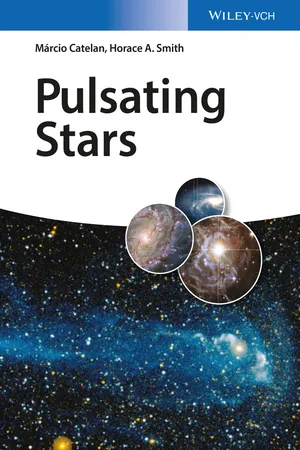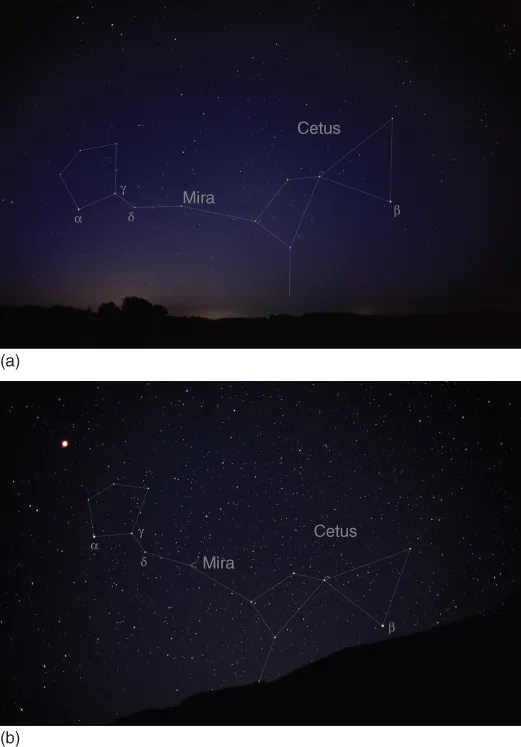
This is a test
- English
- ePUB (mobile friendly)
- Available on iOS & Android
eBook - ePub
Pulsating Stars
Book details
Book preview
Table of contents
Citations
About This Book
This book surveys our understanding of stars which change in brightness because they pulsate. Pulsating variable stars are keys to distance scales inside and beyond the Milky Way galaxy. They test our understanding not only of stellar pulsation theory but also of stellar structure and evolution theory. Moreover, pulsating stars are important probes of the formation and evolution of our own and neighboring galaxies. Our understanding of pulsating stars has greatly increased in recent years as large-scale surveys of pulsating stars in the Milky Way and other Local Group galaxies have provided a wealth of new observations and as space-based instruments have studied particular pulsating stars in unprecedented detail.
Frequently asked questions
At the moment all of our mobile-responsive ePub books are available to download via the app. Most of our PDFs are also available to download and we're working on making the final remaining ones downloadable now. Learn more here.
Both plans give you full access to the library and all of Perlego’s features. The only differences are the price and subscription period: With the annual plan you’ll save around 30% compared to 12 months on the monthly plan.
We are an online textbook subscription service, where you can get access to an entire online library for less than the price of a single book per month. With over 1 million books across 1000+ topics, we’ve got you covered! Learn more here.
Look out for the read-aloud symbol on your next book to see if you can listen to it. The read-aloud tool reads text aloud for you, highlighting the text as it is being read. You can pause it, speed it up and slow it down. Learn more here.
Yes, you can access Pulsating Stars by Márcio Catelan,Horace A. Smith in PDF and/or ePUB format, as well as other popular books in Ciencias físicas & Astronomía y astrofísica. We have over one million books available in our catalogue for you to explore.
Information
Chapter 1
Historical Overview
1.1 Discovery of the First Pulsating Variable Stars
Although cataclysmic variable stars of the nova or supernova type had been seen since antiquity (Stephenson & Green, 2002), by the sixteenth century stars were generally regarded as fixed and unchanging in both position and brightness (Hoskins, 1982). The outburst of a bright supernova in Cassiopeia in 1572 (Tycho's supernova) startled the astronomical community and reawakened interest in apparently new stars. Almost 14 years later, in 1596, David Fabricius (1564–1617) observed what he thought was yet another new star, this time in the constellation Cetus.
Fabricius's new star was only of the third magnitude, far less brilliant than Tycho's supernova, but nonetheless easily visible to the unaided eye. First seen in August, by October the star had faded below naked-eye visibility. However, Fabricius's star had not forever vanished. A few years later, it was recorded by Johann Bayer, who named the star omicron (o) Ceti and placed it on his 1603 star charts, although Bayer appears to have been unaware that he had rediscovered Fabricius's nova. In 1609, it was Fabricius himself who was surprised to see the new star make a reappearance. While o Ceti certainly seemed unlike Tycho's new star of 1572, Fabricius did not suspect that he had discovered a star that was not a nova but one that instead showed periodic changes in brightness (Hoskins, 1982).
In 1638, Johannes Holwarda (1618–1651) made yet another independent discovery of o Ceti. Like Fabricius, Holwarda watched the star fade from view, only to see it subsequently reappear. Now other astronomers began to pay increased attention to the variable, but nonetheless the periodic nature of its variability still eluded recognition.
Johannes Hevelius (1611–1687) carried out a detailed study of o Ceti, and, in 1662, he published Historiola Mirae, naming the star Mira (meaning the wonderful in Latin), a name which has ever since been applied to it. Ismael Bullialdus (1605–1694) made the next advance. He noticed that the peak brightness of Mira occurred about a month earlier each year, finally discovering the cyclic nature of its brightness changes. In his 1667 Ad astronomos monita duo he determined the period to be 333 days, about 1 day longer than the current determination of the mean period. Mira thus became the first variable star whose period was determined, and the archetype of the class of long-period variable stars now known as Mira variables. It would nonetheless be a long while before it was established that Mira's brightness changes had anything to do with pulsation (Hoskins, 1982).
Mira itself can become as bright as second or third magnitude at maximum light, making it easily visible to the naked eye (Figure 1.1). Other long-period variables, although not as bright as Mira, also have peak magnitudes that place them within the bounds of naked-eye visibility. That begs the question of whether Mira or other long-period variables might have been discovered before the time of Fabricius. Hoffleit (1997) summarized the evidence for pre-1596 observations of Mira. A number of possible pre-1596 observations have been suggested, going back to ancient times. Unfortunately, for none of the proposed pre-discovery observations is the historical evidence ironclad. The case is perhaps strongest for a 1592 “guest star” recorded in Asian records. However, Stephenson & Green (2002) concluded that even that object was unlikely to have actually been Mira.

Figure 1.1 Mira near maximum (a) and minimum (b) light. The image (a) was taken from Römerstein, Germany, on July 17, 2004, whereas the image (b) was obtained on October 30, 2005, from Austria. Several of the nearby stars in Cetus are identified by their Bayer designations, and the Cetus constellation itself is also drawn. The bright object on the upper left corner in (b) is the planet Mars. The July 2004 image presents a view similar to that seen by David Fabricius at his discovery of that long-period variable star in August, 1596. (Images courtesy Till Credner, AlltheSky.com.)
The number of confirmed periodic variable stars increased only slowly following the recognition of the periodicity of Mira. For instance, in 1686 Gottfried Kirch discovered the variability of χ Cygni, a Mira variable with a period of 408 days (Sterken, Broens, & Koen, 1999). R Hydrae, a 384-day-period Mira variable, was found by Maraldi in 1704. A third Mira variable, 312-day-period R Leonis, was found by Koch in 1782. The long-period variability of these stars, and of Mira itself, would eventually be attributed to pulsation. However, little was known of shorter-period variable stars when the British team of Edward Pigott and John Goodricke took up the study of variable stars in earnest late in the eighteenth century.
Pigott and Goodricke soon confirmed the variability of Algol1 (β Persei), which had been originally established by Geminiano Montanari, and determined its period. Goodricke, in a 1783 report to the Royal Society, suggested that an eclipse might be responsible for the periodic dimming of Algol's light. Pigott dis...
Table of contents
- Cover
- Related Titles
- Title Page
- Copyright
- Dedication
- Preface
- Chapter 1: Historical Overview
- Chapter 2: Fundamentals of Stellar Variability Observations
- Chapter 3: Classification of Variable Stars
- Chapter 4: Stellar Structure and Evolution Theory
- Chapter 5: Stellar Pulsation Theory
- Chapter 6: RR Lyrae Stars
- Chapter 7: Cepheid and Related Variable Stars
- Chapter 8: Red Variable Stars
- Chapter 9: Pulsating Stars Close to the Lower Main Sequence in the H-R Diagram
- Chapter 10: Pulsating Stars Close to the Upper Main Sequence in the H-R Diagram
- Chapter 11: Pulsating Supergiant Stars
- Chapter 12: Hot Subdwarf Pulsators
- Chapter 13: Pulsating Degenerate Stars
- Glossary
- References
- Index
- End User License Agreement